
The A-171-4 Quad Slew Limiter is the youngest member of Doepfer’s family of polyphonic modules. What they all have in common is a four-fold layout of the functionality. All of these are influenced by common controllers and/or common control voltages. In addition, all Poly modules (at least in current production) have the option of internal pre-wiring with jumper cables, which in most cases ensures significantly “tidier” patch fields.
This is also the case with the new poly slew limiter, which in most cases will probably be used for polyphonic portamento – i.e. the smoothing of pitch control voltages. The four units have separate inputs and outputs with a common manual control and a common control voltage input with attenuator. There are four pins on the boards “under the hood” for the inputs and outputs, the entire module is again designed as a “Slim Line” module: We have slightly narrower knobs and the convenient “controls up – jacks down” layout like most other Poly modules.
User interface
Inputs:
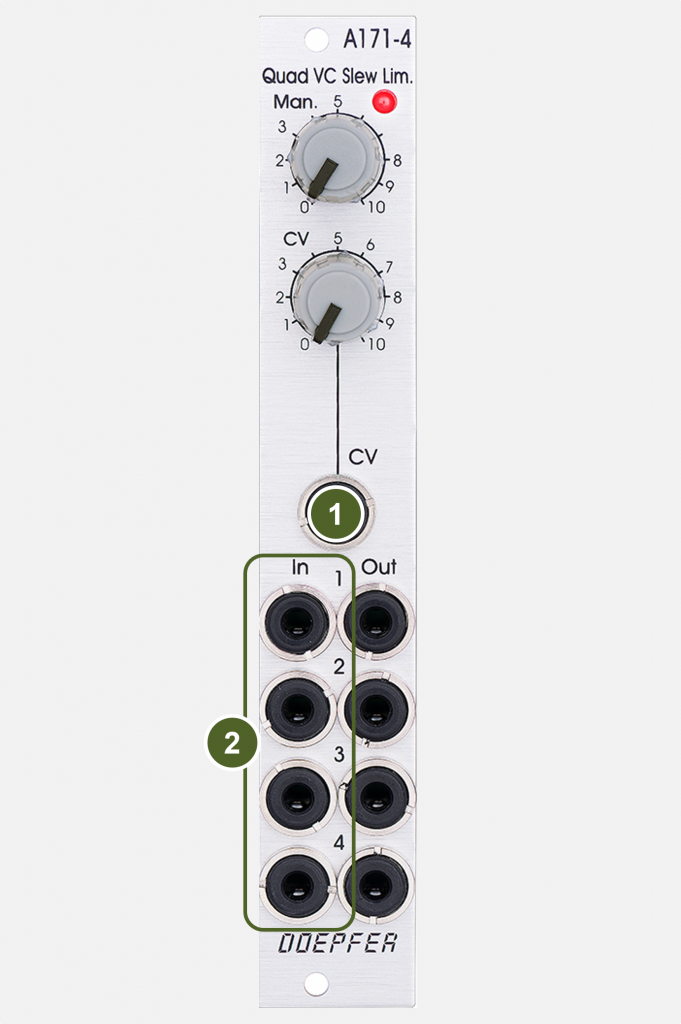
- CV: Common control voltage input for all four slew limiters. Higher voltages result in faster portamento. The “CV” control is the attenuator for this input. The voltage present here is added to the internal voltage from the “Man.” controller. The LED on the top right always shows the mixture of manual control and external control voltage. Negative voltages are possible as well, they then lead to a longer portamento than preset with “Man.”.
- In 1 to 4: Four inputs for control voltages. Normally you would connect the “CV Note” outputs from the A-190-5 here, for example, in order to generate slower pitch transitions (portamento) from abrupt note changes. But in principle we can of course apply any control voltages here, which should then be “polished” together. The four sockets are designed as switching sockets, so pre-wiring on the board is interrupted by plugging in a cable.
Outputs:
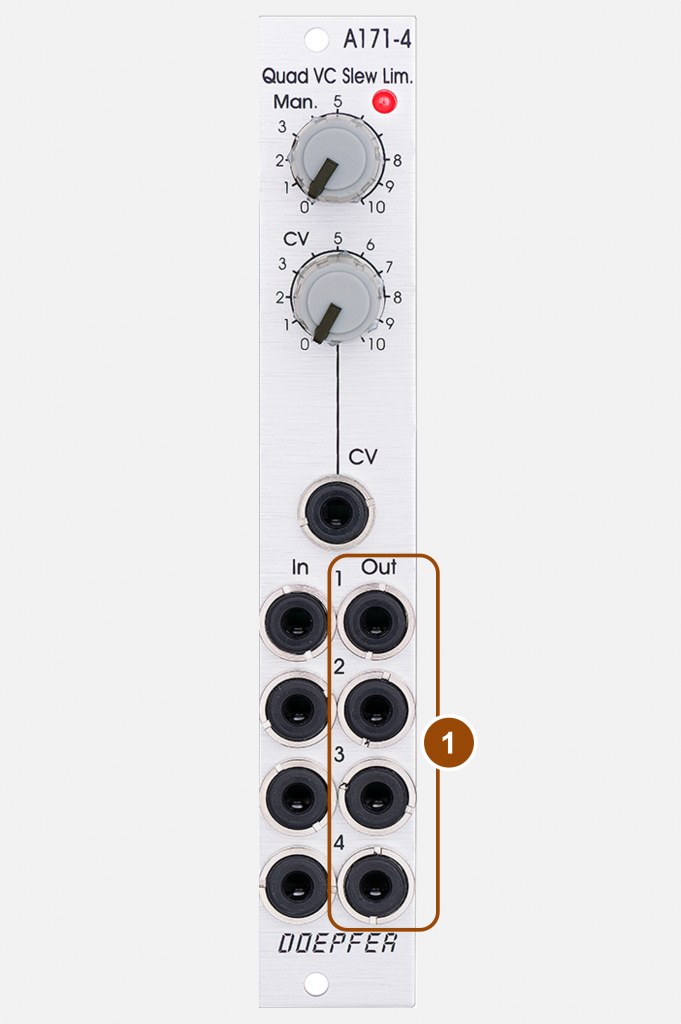
Controls:
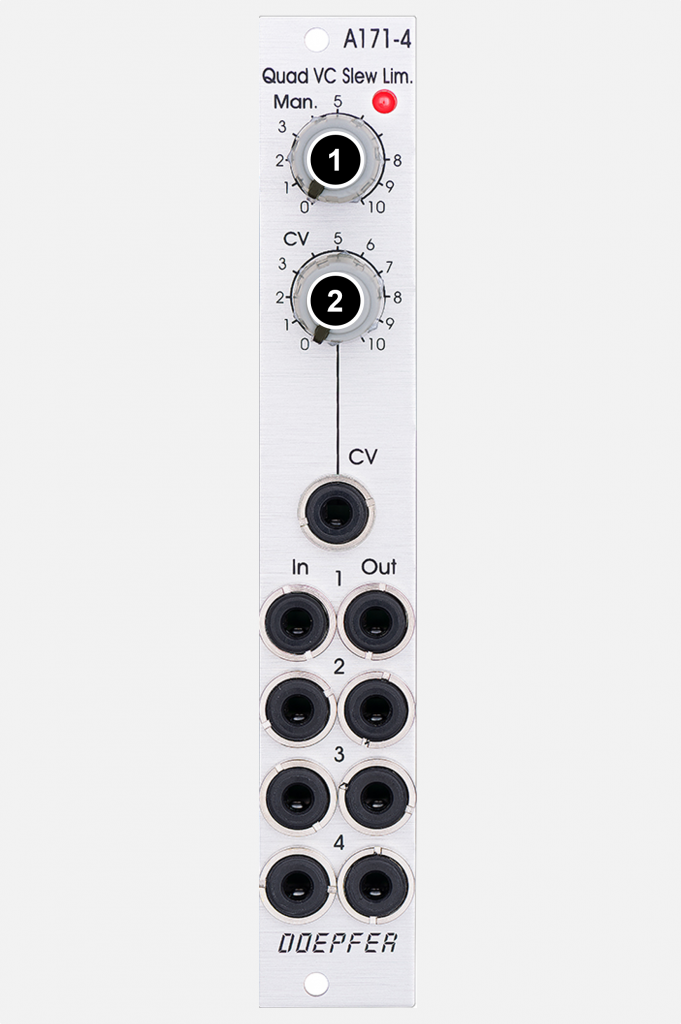
- Man.: Manual controller for the polyphonic portamento – or in general: for the intensity of the smoothing of the four applied control voltages. In position 10 there is no portamento at all, in position 0 the maximum smoothing of the control voltages.
- CV: Attenuator for the control voltage input “CV”.
It’s actually a filter…
What is striking? The following applies both to the control voltages and to the manual “Man.” controller: Maximum voltage or maximum controller position: No portamento at all. Minimum or negative voltage or “Man.” control set to 0: Maximum portamento.
This is strange at first, since one usually wants to add a “portamento effect” via the controller/control voltage. Instead, one can – to put it bluntly – eliminate the lack of portamento…
Everything becomes clearer when you understand the module as a polyphonic low-pass filter: When set to maximum, every LP filter lets all frequencies through, including the very high ones. The further we lower the cutoff frequency, the more the audio signal is smoothed and the fast, high frequencies disappear.
If you apply this to pitch control voltages instead of audio signals, then abrupt changes will also pass through unchanged at maximum position and the more we filter, the smoother the transitions between the individual tones (or their control voltages).
Configuration via the board
Here we are – for once – not dealing with a wide range of configuration options on the circuit board. There are no jumpers for special functions or individual characteristics, etc. Nevertheless, it is worth taking a look at the boards behind the front panel: All four inputs and outputs of the module can be pre-assigned via jumper pins.
Inputs
The inputs will probably be connected in 99% of the cases to the “CV Note” outputs on the board of the polyphonic A-190-5 midi CV interface. If you want to use something else (external sequencer, polyphonic random number generator A-149-4, polyphonic CV keyboard like Arturia KeyStep Pro etc.), then you simply use the four “In” switching sockets on the front panel, which interrupt the pre-assigned connections. A very practical solution, as with all Doepfer poly modules.
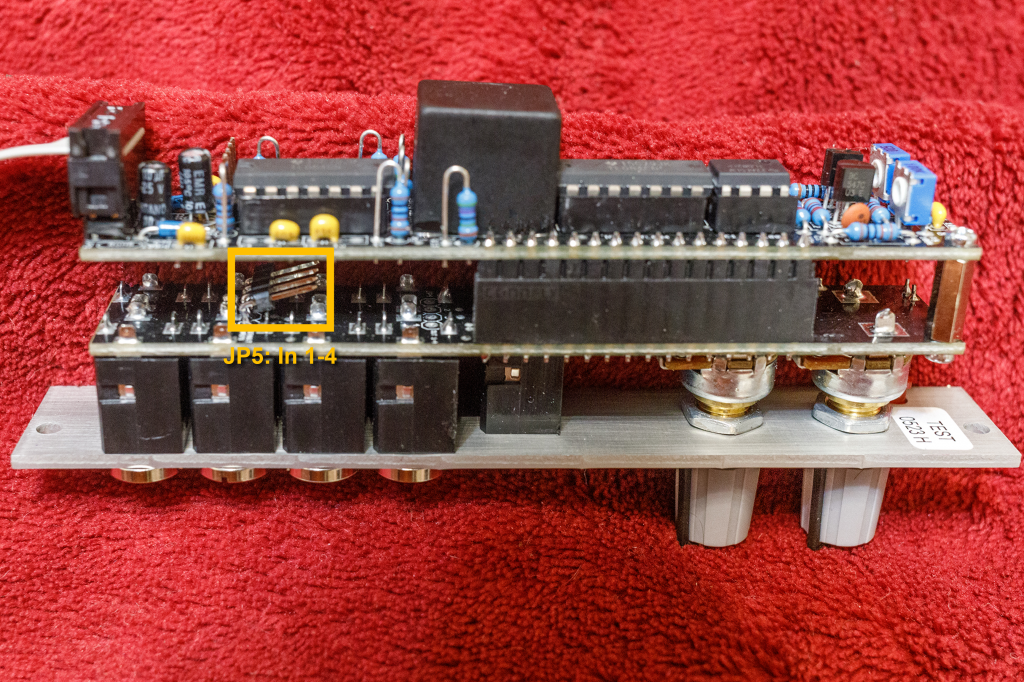
Outputs
There are also four pins on the circuit board for the outputs of the slew limiter. If we use the module as a polyphonic portamento, then a pre-assigned connection with something like an A-111-4 VCO is a good idea.
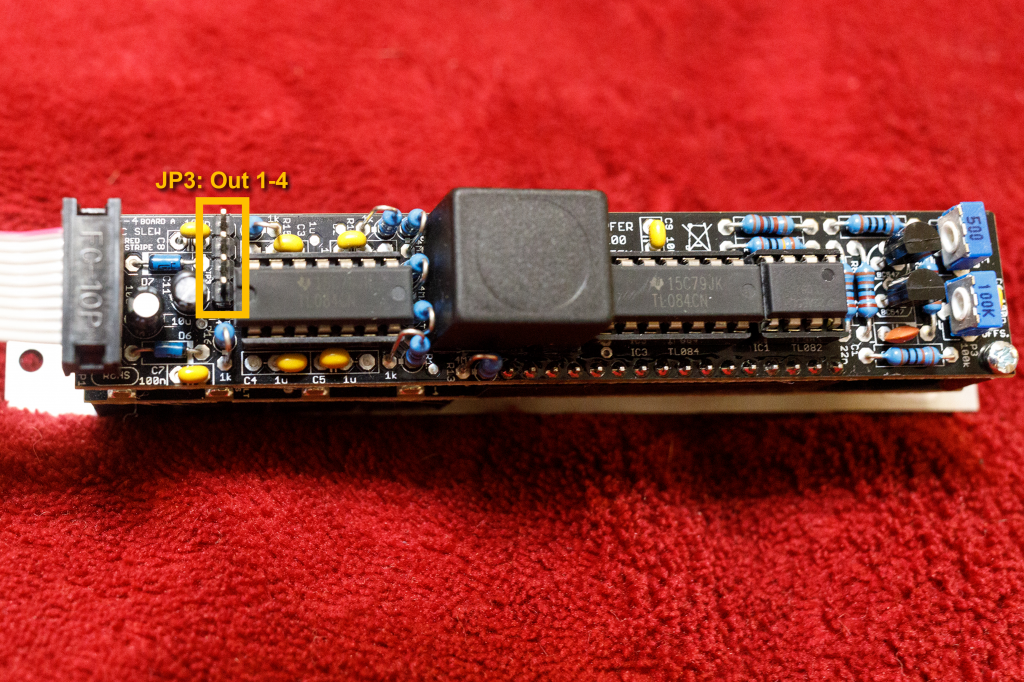
Possible uses
The module is ideal for creating a very “analog” portamento for polyphonic applications. Why am I emphasizing the “analogue” here? The module uses photoresistors to smooth the input voltages. Due to their design, they never work completely the same, i.e. the portamento times between individual voices of the poly-synth will always react slightly differently. This means that a portamento between two chords in the transition phase is always very slightly different in speed / asynchronous / out of tune, which then makes the portamento effect very lively.
In addition to this very obvious area of application, the module can also be used, for example, to smooth out polyphonic modulations (e.g. to move four square LFOs in the direction of sine waves or to soften four “snappy” envelope curves).
But the A-171-4 can even be used in the audio field. After all, this slew limiter is a (6 dB) low-pass filter. And you can use something like that in addition to the “normal” filter, or for individual sound components, such as noise or a single VCO. In contrast to the A-105-4, for example, the four filters cannot be controlled independently of each other, so use with an A-141-4 as a modulation source is not possible.
Sound examples
-
A-190-5, A-171-4 / Poly-Portamento comparison
Now we have two options for creating polyphonic portamento: digitally in the A-190-5 or analogue with light-sensitive resistors in the A-171-4. I use four A-111-6 miniature synthesizers, with an A-138s mini stereo mixer spread out in panorama, the A-190-5 is set to “Poly 1”. Some reverb and delay from the DAW.
We hear a simple sequence from an Arturia KeyStep Pro, first with the digital portamento from the A-190-5 (portamento set to 30) – two passes.
Afterwards (from 1:12”) the digital portamento is set to 0 and an A-171-4 Quad VC Slew Limiter generates the portamento (“Man.” set to 2) – also two passes of the sequence. You can clearly hear that the individual voices take slightly different amounts of time to reach their target values.
Polyphonic portamento digital with the A-190-5 and analog with the A-171-4. -
A-171-4 / Slow chords
In this sound example, the sawtooth signals from two A-111-4 VCOs (distance 2 octaves) are mixed via two A-138f dual crossfaders and further processed with the A-105-4 poly filter and the A-132-8 poly VCA. Filter and VCA are each controlled by an A-141-4 Poly-ADSR, the two VCAs each have a separate LFO for light vibrato.
I’m manually playing a quad chord through an A-190-5 midi interface that controls the VCOs and envelopes. An A-171-4 Quad Slew Limiter is connected between the interface and the VCOs, set to minimum (i.e. maximum slewing of the pitch CV), then the same chord 3 octaves down, 4 octaves up and 5 octaves down. Some reverb and delay from the DAW.
Slow chords with lots of portamento. -
A-171-4 / Chord Sequence
In this sound example, the sawtooth signals from two A-111-4 VCOs (distance 2 octaves) are mixed via two A-138f dual crossfaders and further processed with the A-105-4 poly filter and the A-132-8 poly VCA. Filter and VCA are each controlled by an A-141-4 Poly-ADSR, the two VCAs each have a separate LFO for light vibrato.
An Arturia Keystep Pro delivers a simple chord sequence and controls the VCOs and envelopes via an A-190-5 midi interface. An A-171-4 Quad Slew Limiter is connected between the interface and the VCOs, which is initially set to maximum (i.e. no smoothing of the pitch CV), after which portamento slowly fades in from 0:45” and finally fades out again. Some reverb and delay from the DAW.
Chord sequence with portamento. -
A-171-4, A-149-4 / Filter modulation with smoothed randomness
In this sound example, two A-111-4 VCOs (sawtooth, 1 octave apart) are mixed and processed with the A-105-4 Poly-VCF and A-132-8 Poly-VCA. The VCA is controlled by an A-141-4 Poly ADSR, the filter by an A-149-4 Quad Random Generator (no ADSR).
The four random generators are triggered (simultaneously) by the drum triggers of an Arturia KeyStep Pro, the rest by a polyphonic arpeggio, also by the Arturia keyboard (using the A-190-5 as a midi-CV interface). The four outputs of the A-149-4 are processed by the A-171-4 before controlling the cutoff frequencies of the filters in the A-105-4.
Incidentally, the frequencies of the poly filter are not controlled by the A-190-5 here (default connections on the board are interrupted). So the random module is the only modulation source for the A-105-4.
I start with a low range in the A-149-4 and no resonance in the filter, manually fade in and out the looping in the A-171-4, increase the resonance, vary the input volume in the filter, the range in the random generator, etc. Some reverb and delay from the DAW.
Poly arpeggio with random control of the filters and slew limiter for the filter modulations.
Alternatives
No, there are no real “alternatives” for the module. If you are lucky enough to own one of the rare and no longer produced vocoder subsystems A-129-1/2, A-129-3, A-129-4 and A-129-5, you can of course use the fivefold slew limiter (A-129-3 and the indispensable controller A-129-4) in a polyphonic setup. Apart from that, you could still use four A-170 Dual Slew Limiters, but then you would need eight times the space of the A-171-4 at more than four times the price.
In early 2024, Doepfer released a pretty exciting software update for its polyphonic A-190-5 Midi interface. In addition to an alternative algorithm for vote distribution and many detailed improvements, it now also offers a digitally controlled portamento option. This produces much more “precise” transitions than the A-171-4 with its very organically working photo diodes: You can find this “better” or “worse”, or – like me – you can be happy that you now have the choice to select the portamento according to the musical context.
Technical specifications
| Width | 4 HP |
| Depth | 45 mm |
| Power requirements | 40 mA (+12V) / -40 mA (-12V) |